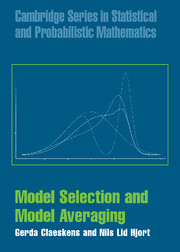Book contents
- Frontmatter
- Contents
- Preface
- A guide to notation
- 1 Model selection: data examples and introduction
- 2 Akaike's information criterion
- 3 The Bayesian information criterion
- 4 A comparison of some selection methods
- 5 Bigger is not always better
- 6 The focussed information criterion
- 7 Frequentist and Bayesian model averaging
- 8 Lack-of-fit and goodness-of-fit tests
- 9 Model selection and averaging schemes in action
- 10 Further topics
- Overview of data examples
- References
- Author index
- Subject index
9 - Model selection and averaging schemes in action
Published online by Cambridge University Press: 05 September 2012
- Frontmatter
- Contents
- Preface
- A guide to notation
- 1 Model selection: data examples and introduction
- 2 Akaike's information criterion
- 3 The Bayesian information criterion
- 4 A comparison of some selection methods
- 5 Bigger is not always better
- 6 The focussed information criterion
- 7 Frequentist and Bayesian model averaging
- 8 Lack-of-fit and goodness-of-fit tests
- 9 Model selection and averaging schemes in action
- 10 Further topics
- Overview of data examples
- References
- Author index
- Subject index
Summary
In this chapter model selection and averaging methods are applied in some usual regression set-ups, like those of generalised linear models and the Cox proportional hazards regression model, along with some less straightforward models for multivariate data. Answers are suggested to several of the specific model selection questions posed about the data sets of Chapter 1. In the process we explain in detail what the necessary key quantities are, for different strategies, and how these are estimated from data. A concrete application of methods for statistical model selection and averaging is often a nontrivial task. It involves a careful listing of all candidate models as well as specification of focus parameters, and there might be different possibilities for estimating some of the key quantities involved in a given selection criterion. Some of these issues are illustrated in this chapter, which is concerned with data analysis and discussion only; for the methodology we refer to earlier chapters.
AIC and BIC selection for Egyptian skull development data
We perform model selection for the data set consisting of measurements on skulls of male Egyptians, living in different time eras; see Section 1.2 for more details. Our interest lies in studying a possible trend in the measurements over time and in the correlation structure between measurements.
Assuming the normal approximation at work, we construct for each time period, and for each of the four measurements, pointwise 95% confidence intervals for the expected average measurement of that variable and in that time period.
- Type
- Chapter
- Information
- Model Selection and Model Averaging , pp. 248 - 268Publisher: Cambridge University PressPrint publication year: 2008
- 2
- Cited by



